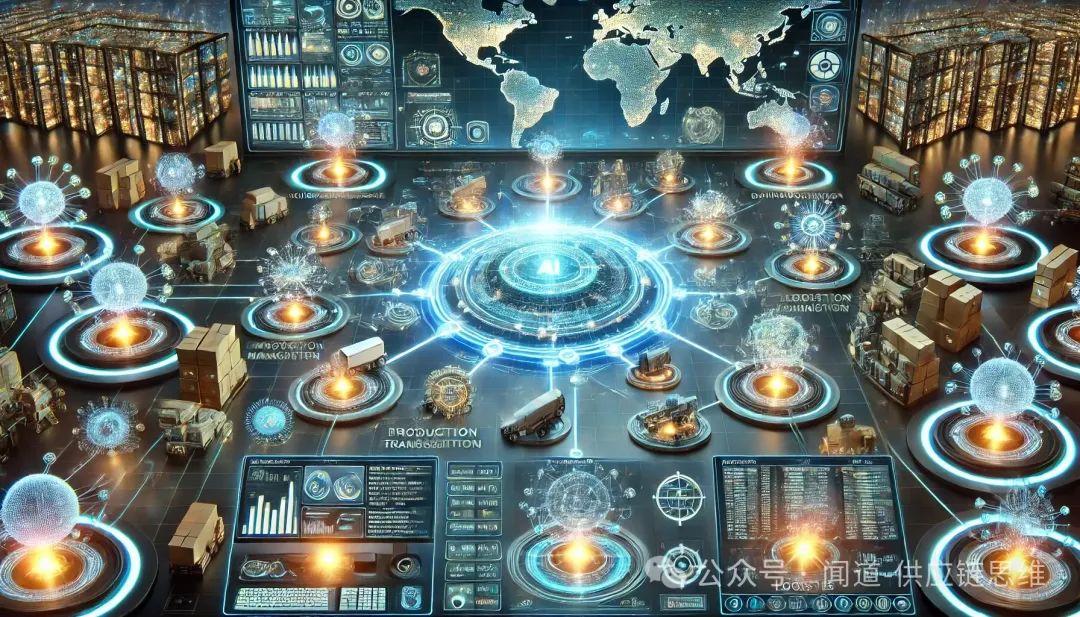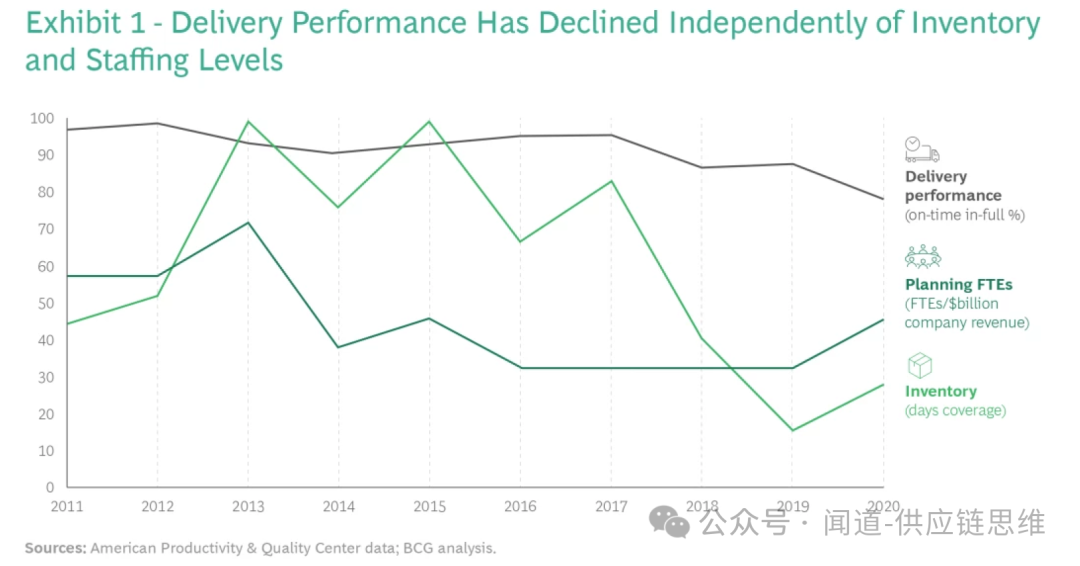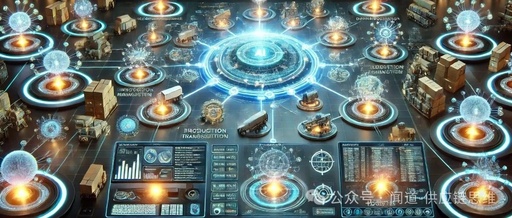In a famous article titled “The Death of Supply Chain Management” published in the Harvard Business Review in 2018, experts predicted that the function of supply chain management would be replaced by automated systems within 5-10 years. This bold prediction sparked widespread discussion at the time. The article mentioned:“The trend is clear: technology is replacing personnel in supply chain management, and it does so better. It’s not hard to imagine that in the future, automated processes, data governance, advanced analytics, sensors, robotics, artificial intelligence, and continuous learning loops will minimize the need for humans. But when planning, procurement, manufacturing, order fulfillment, and logistics are fundamentally automated, what will be left for supply chain professionals?”
This vision depicts a self-regulating supply chain system capable of autonomously optimizing end-to-end workflows. At the core of this transformation is the establishment of a digital foundation. The capture, analysis, and integration of high-quality, real-time data fuel process automation, predictive analytics, artificial intelligence, and robotics. These technologies collectively form the cornerstone of future supply chain management, heralding the end of traditional management practices.

The Failures of Traditional Digitization and AI
An analysis by Boston Consulting Group of key supply chain performance indicators (KPIs) from 2011 to 2020 revealed the failures of expert predictions: despite investing billions in digital transformation, delivery performance continued to decline, completely disconnected from increased inventory and staffing levels. Even when companies significantly increased inventory and staffing levels at the onset of the COVID-19 outbreak, service quality plummeted. This is not merely an efficiency issue but a systemic collapse of the traditional supply chain management model.

In the face of this systemic failure, companies continue to increase investment in the wrong direction. Surveys reveal this fatal misconception: companies concentrate AI investments on reinforcing traditional sub-functions – demand forecasting, inventory replenishment models, production scheduling, etc., while almost completely ignoring the true game-changer: autonomous decision-making systems. This “patching the broken system” mindset leads to a vicious cycle: the more investment in traditional frameworks, the greater the complexity and fragility of the supply chain, the lower the service levels, and the more difficult inventory optimization becomes, increasing human burdens.
Why has traditional AI completely failed? The reason is not that the technology itself is not advanced enough, but rather a fundamental misunderstanding of the nature of the problem. The fatal weakness of traditional supply chain management lies in its structure: it is a fragmented system composed of isolated departments, each driven by organizational structure and incentive systems to optimize its own metrics rather than overall value. Traditional AI is forced to adapt to this fragmented structure, resulting only in accelerating information asymmetry and suboptimal decisions between departments. Worse, it generates vast amounts of data without the capability to make cross-system integrated decisions, thus increasing the cognitive burden on humans. This is not a technological failure but a paradigm failure.
The mindset of enterprises becomes the last straw. They cling to three fatal assumptions: first, they believe that consensus decision-making can bridge the gaps between functions; second, they overly trust that humans can effectively understand and process complex data; third, they blindly rely on linear technological upgrades rather than fundamental restructuring. These assumptions lead enterprises to continually reinforce the wrong path, investing heavily in systems doomed to fail.
Revolutionary Breakthroughs of Generative AI
Generative AI is not just the next step in AI development; it represents a leap in computer cognition, redefining the essence of “decision-making”.
Generative AI introduces three revolutionary breakthroughs that collectively create the necessary conditions for the end of supply chain management: first, it radically changes the human-computer interaction model from complex interfaces to natural language understanding; second, it possesses true cross-domain reasoning capabilities, connecting knowledge silos divided by organizational boundaries; most importantly, it establishes a network of autonomous agents that can collaborate and continuously learn to make complex decisions without human intervention.
The core advantage of generative AI lies in its subversion of the concept of “expertise”. Traditional supply chain management relies on scarce expert knowledge and complex tools, which have significant usage barriers between them. Generative AI not only breaks down these barriers but completely reconstructs the distribution model of expertise – democratizing demand forecasting, supply planning, and advanced analytics from the hands of experts, allowing anyone to gain insights that surpass human experts. This is not just an efficiency improvement; it fundamentally redefines the concept of “professionalism”.
Even more disruptive, generative AI fundamentally changes the essence of “decision-making”. It no longer merely provides information for humans to make decisions; instead, it creates an ecosystem of autonomous agents capable of making complex judgments, predicting outcomes, and taking action without human intervention. These agents need to be explicitly programmed, capable of observing, learning, and continuously improving – a capability boundary that traditional AI can never reach.
We can see these advantages emerging from a test of Deepseek’s reasoning capabilities. To explore Deepseek’s reasoning abilities, we used a company’s dataset containing thousands of freight records. First, the goal was to generate segmented views of product features, identifying those with stable sales, seasonal patterns, or trends. Through several targeted prompts, Deepseek quickly delivered the required segments.
In demand planning, Deepseek was assigned to perform basic time series forecasting. It efficiently selected the appropriate forecasting method based on the discovered sales patterns and wrote code lines to generate predictions. For example, when Deepseek detected seasonal patterns, it recommended using the triple exponential smoothing method, which is the ideal forecasting method in this case. However, the dataset lacked the 24 months of historical data needed to configure model parameters. Impressively, Deepseek flagged this limitation and requested additional data to continue.
The insight here is significant: basic time series forecasting functions, traditionally found only in proprietary software, are now accessible through publicly available tools. However, more advanced AI-driven forecasting techniques will still require specialized modules, which can be coordinated by generative AI.
When turning to supply planning, the results differed. The goal was to optimize the production sequence of certain products on a single asset, considering various factors including production output and changeover time. The aim was to meet customer demand while minimizing inventory accumulation.
In this case, Deepseek acknowledged that the task exceeded its current capabilities, explaining that more complex linear programming solutions were needed. It even suggested useful resources to tackle this challenge.
This finding indicates that while generative AI can handle simpler analytical tasks, optimizing more complex scenarios currently requires specialized tools. In these cases, generative AI can act as an orchestrator and coordinator, guiding processes rather than directly executing solutions.
From this, we can identify four stages of generative AI triggering the demise of supply chain management, which is not a simple technological evolution but a complete transfer of power – an irreversible handover from human decision-makers to autonomous intelligent systems:
Pervasion Stage – The Harbinger of Demise: Generative AI first infiltrates organizations in the form of seemingly harmless chatbots addressing specific task issues. These systems appear merely as tools for increasing efficiency but are actually gathering data, learning processes and decision-making patterns, preparing for a larger takeover. At this stage, humans still control the overall picture, but generative AI has begun quietly observing and learning the patterns of human decision-makers.
Replacement Stage – Core Function Takeover: Generative AI rapidly upgrades, begins to integrate into existing systems, and takes over key functions. It is no longer just suggesting but actively executing tasks such as monitoring supply chain disruptions, generating alerts, and simulating responses. Crucially, generative AI begins to demonstrate advantages over humans at this stage: it never tires, is not influenced by emotions, and can simultaneously process multi-dimensional data. Human decision-makers start to rely on generative AI, unwittingly transferring more decision-making power to it.
Transformation Stage – Fundamental Reconstruction of Human Roles: This is the critical point at which the human role in supply chain management undergoes a fundamental shift. The generative AI agents are no longer tools but partners and leaders. They continuously validate and update master datasets, redesign workflows, and make key decisions under human supervision.
Termination Stage – The Demise of Supply Chain Management: This stage marks the complete demise of traditional supply chain management. The self-organizing network of generative AI agents fully takes over cross-functional processes, including complex sales and operations execution processes. Humans no longer participate in the daily decision-making loop but transition to system designers and strategic guides. It is no longer humans managing the supply chain with AI but AI autonomously managing the supply chain while humans focus on setting business objectives and ethical boundaries. The revolutionary aspect of this paradigm shift is that it does not merely automate existing roles but creates an entirely new operating model, rendering the traditional concept of “supply chain management” obsolete.
AI Agents Disrupt Supply Chain Processes
For example, the Sales and Operations Execution (S&OE) process will soon be transformed by the AI Agent network. This process balances short-term demand, inventory, and supply to maintain performance, evolving from a time-consuming, manual-driven task to an automated, intelligent system capable of running continuously without human intervention.
Currently, dedicated teams follow the S&OE process several times a week, coordinating demand and supply to meet customer orders and maintain KPIs within a planning horizon of 1-12 weeks. While effective, this process is labor-intensive, limited by data availability, and heavily reliant on human oversight to ensure smooth execution.
We anticipate that future S&OE processes will be driven by always-online autonomous collaborating and learning agents that dynamically balance real-time supply chains to ensure continuous optimal performance. These agents will be professional software programs driven by generative AI like Deepseek, continuously interacting with data inputs and adapting to changing conditions. To minimize potential LLM generation errors or hallucinations, agents will operate within business rules and decision frameworks. By processing large datasets, agents will coordinate tasks without human intervention.
In this envisioned system, demand agents will continuously monitor changes in demand forecasts, learning and adjusting actions accordingly. They will utilize specialized machine learning algorithms to generate predictions. Meta agents will act as coordinators, overseeing data flows, extracting new demand information, and cleansing data to eliminate anomalies.
When changes in demand occur, demand agents will collaborate with inventory agents to assess the impact. Meta agents will provide inventory agents with precise, real-time data from various enterprise resource planning systems, enabling them to evaluate supply and inventory adjustments. If KPIs for service, inventory, or costs are at risk, inventory agents will trigger corrective actions, such as inventory transfers or production reorders, to restore balance.
Supply agents will then assess the feasibility of these changes, coordinating with supplier agents or adjusting production plans. If proposed adjustments incur high costs, such as retooling, supply agents will explore alternatives. For example, with support from meta agents, supply agents might collaborate with external optimization tools (like mixed-integer linear programming solvers) to determine the best production sequence.
Through this continuous collaboration, agents will constantly learn and refine their ability to autonomously rebalance the supply chain. In the initial stages, human oversight will be necessary, and agents will submit decisions for approval. However, as the system matures, automation will increase—particularly in handling transactional tasks—until agents ultimately make decisions independently within a widely automated network.
Ultimately, the decisions of this autonomous system will be directly input into execution systems, seamlessly coordinated by meta agents. This will help the entire supply chain maintain continuous optimization and fully align with the company’s strategic objectives.
As supply chains become increasingly complex and talent shortages worsen, generative AI is becoming key to maintaining competitiveness. It promotes higher adoption rates of AI tools through user-friendly interfaces and agent-based automation. It also excels in cross-functional coordination, connecting different systems and teams to achieve faster, more coordinated actions. The result—in terms of productivity and flexibility improvements—proves that embracing generative AI enhances competitive advantage and is a vital strategy for future supply chains.
The prophecy of the death of supply chain management may have been premature, but its complete transformation has already begun. By embracing the potential of generative AI and taking a structured approach to realizing its promises, companies can develop more adaptive, efficient, and resilient supply chains, preparing for future success.
Related Original Long Reads:
The Antidote to the Fog of Supply Chain Technology: Gartner’s Technology Maturity Curve
12,800 Words of Ultimate Logical Deduction! Deepseek Solved the Logistics Network Optimization Problem Using Exhaustive Search
Deepseek + Logistics Expert Knowledge: From Chaos to Order, From Doubt to Breakthrough
In these restless times, reading long articles is not easy; you are unique!If this article has helped you, or if you are interested in the field of supply chain and logistics, don’t forget togive alike, andshare it with more friends. Every like and share is the greatest support for the author’s creation and helps more people understand the dynamics and trends in the industry.
